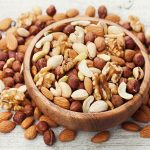
From positive effects on cholesterol levels to reducing the risk of heart disease and even some cancers, nuts are good for you. Ounce for ounce, they are nutrient powerhouses with beneficial fats and plant protein. Many studies recommend eating 1-1/2 ounces of nuts a day, but which are best? High levels of nutrients put these at the top of the list. Pistachios have antioxidants including lutein, important for eye health, beta-carotene and vitamin E. Eating pistachios may help lower “bad” LDL cholesterol and maintain heart health, according to Penn State researchers. Shelling them yourself prolongs your enjoyment. One ounce is equal to 45 to 50 pistachios. Almonds are an excellent source of vitamin E and magnesium, plus a good jolt of calcium. A Korean study found that eating about two ounces of almonds a day can improve levels of all blood fats, including triglycerides. A University of Florida study found that their fiber content could boost good bacteria in the gut and good health in general. One ounce is equal to about 24 almonds. Hazelnuts, or filberts, are also rich in vitamin E as well as the minerals copper and manganese. They’re being studied, along with almonds and walnuts, as a food to protect brain health. One ounce is equal to 15 to 20 hazelnuts. Pecans are high in antioxidants and heart-healthy monounsaturated fats. A… read on >

















